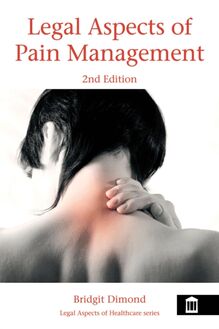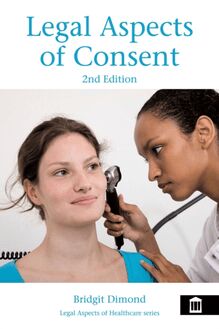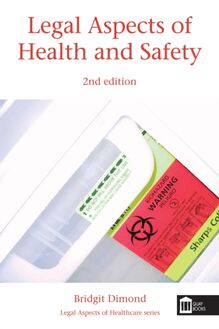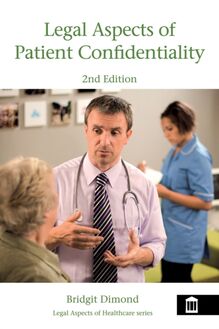Legal Aspects of Pain Management 2nd Edition , livre ebook
116
pages
English
Ebooks
2016
Vous pourrez modifier la taille du texte de cet ouvrage
Obtenez un accès à la bibliothèque pour le consulter en ligne En savoir plus
Découvre YouScribe et accède à tout notre catalogue !
Découvre YouScribe et accède à tout notre catalogue !
116
pages
English
Ebooks
2016
Vous pourrez modifier la taille du texte de cet ouvrage
Obtenez un accès à la bibliothèque pour le consulter en ligne En savoir plus
Publié par
Date de parution
01 juin 2016
Nombre de lectures
0
EAN13
9781856424561
Langue
English
Title page
Legal Aspects of Pain Management
Second edition
British Journal of Nursing monograph Legal Aspects of Health Care series
Bridgit Dimond
MA, LLB, DSA, AHSM, Barrister-at-law,Emeritus Professor of the University of Glamorgan
Publisher information
2016 digital version by Andrews UK Limited
www.andrewsuk.com
Quay Books Division, MA Healthcare Ltd, St Jude’s Church, Dulwich Road, London SE24 0PB
© MA Healthcare Limited 2010, 2016
All rights reserved. No part of this publication may be reproduced, stored in a retrieval system or transmitted in any form or by any means, electronic, mechanical, photocopying, recording or otherwise, without prior permission from the publishers
Note
Healthcare practice and knowledge are constantly changing and developing as new research and treatments, changes in procedures, drugs and equipment become available.
The author and publishers have, as far as is possible, taken care to confirm that the information complies with the latest standards of practice and legislation.
Foreword
Ilora G. Finlay Finlay, FRCP FRCGP
Pain is perhaps the most feared of all the sensations. It generates fear and despair, breaks the victim in its wake and tortures the onlooker, be that family or friend. Old fears of morphine as a potent and potentially lethal drug gave way in the 1970s to a realisation that the drug was an effective analgesic. When administered orally and titrated up to achieve analgesia, it provides pain relief without shortening life. Yet the abuses became evident in society with addiction, tales of ‘double effect’ and the murderous intent of Shipman.
Lessons from other countries are important. The legalisation of euthanasia in Holland, until recently not legalised but simply not prosecuted when administered within guidelines, has resulted in a swing back amongst professionals. Awareness of the need for palliative care education and training has increased and doctors are realising that every single patient needs to be able to access good symptom control. As Robert Twycross so often said, ‘You do not need to kill the patient to kill the pain.’
The law can seem a blunt instrument when a clinician confronts the myriad of clinical issues in any one patient and tries, sometimes without success, to come to a sound decision in the patient’s best interest. We can all learn from the precedents that have made case law. European law is now supplementing this legal framework in England and Wales; it is increasingly shaping the attitudes of society to clinical decision-making processes. Yet lawyers often seem terrifying to clinicians, as if they are ready to pounce on any error to make capital out of it, ignorant of the difficulties and uncertainties the clinician faces, as the law appears to set absolutes that may be open to misinterpretation. Patient autonomy is a phrase much bandied about. Often forgotten is the irrefutable principle that each person is autonomous and the autonomy of one cannot override the autonomy of another within the principles of bio-medical ethics.
The contextual legal framework, within which care is delivered to those who are suffering, highlights why failure to respect the duty of care has severe consequences in law. This book sensitively takes the clinical scenario and explores it, providing references and teaching challenges for discussion. For the next generation of healthcare professionals decisions will become harder, not easier. The internet with its information explosion creates new challenges as patients and their families can access vast mounts of unclassified information; some is based on sound scientific enquiry, some is based on validated human experience. But amongst the ‘information’ of ‘pseudo- information’ is much that is simply whim or exploitation of the vulnerable. It is through this minefield that the clinician must steer the person in distress. And as increasingly difficult decisions are taken, ignorance of the law is no defence.
Preface
I welcomed the opportunity to bring this small book up to date. Much has happened in both statute and common law since the First Edition. In particular the Mental Capacity Act 2005 has at long last filled the gap which existed in statute law on decision making on behalf of those incapable of making their own decisions. The aims of the book remain the same: to bring an understanding of the law relating to the management of pain to the many health and social care professionals, including their managers and their tutors in an easy to read succinct way. I also hope that the book will be useful to patients and patient representatives and their organisations. If practitioners have confidence in the law which applies to their practice, then they can concentrate on their work of caring for the patient. If patients understand the law which applies to their situation and their legal rights, then their dialogue with their health and social care professionals can be constructive and meaningful.
Bridgit Dimond
Preface to the First Edition
In 1987 I was seconded from the then Polytechnic of Wales (now the University of Glamorgan) to work with South Glamorgan Health Authority and during that time acted as patient’s representative at the Cardiff Royal Infirmary. During my work there we set up several multidisciplinary brainstorming groups to resolve intractable problems in the hospital. One of these was the difficulties of patients who had come to the Accident and Emergency Department with injuries or conditions which required the examination by doctors from other specialities in the hospital, such as paediatrics, orthopaedics, etc. It was the policy that pain relief should not be administered by the Accident and Emergency staff until the patient had been seen by the specialist doctor. Unfortunately this could involve seriously long waiting times for the patients and the situation was clearly unacceptable. One of the members of the brainstorming group was Ann Taylor, a nurse from the Intensive Care Unit. Subsequently, she developed an interest in pain management and moved from the Cardiff Royal Infirmary to the University Hospital of Wales, where she now works in the Department of Anaesthetics and Intensive Care. She initiated an international course for multidisciplinary health professionals in pain management and this has since been developed to Masters degree status with other lecturers involved. Ann’s work in this field was subsequently recognised when she was appointed as Welsh Woman of the Year in 1999.
It has been my privilege to give the legal input to the course and it has always been evident to me that a book covering the legal aspects of pain management would be a useful adjunct not only to those on the pain management course and other similar courses, but to all those many health professional from a wide range of specialities who have to deal with many complex legal issues relating to pain management. It should also be of benefit to patient groups and relatives and others involved in palliative care. This book is written for all such people. Because of the variety of their disciplines, the generic term (pain) practitioner will be used, and because the majority are female ‘she’ and ‘her’ will be used to denote an individual. Many readers may not be acquainted with basic facts of the legal system and so these are briefly set out in early chapters. It is hoped that the book will provide a succinct, useful basis from which practitioners and others can extend their knowledge of the law for the protection of their patients, their colleagues and themselves. In recognition of the origins of these writings and her significant work in pain management, the book is dedicated to Ann Taylor.
Bridgit Dimond
Acknowledgements
Many people have assisted me in the preparation of this book, particularly those who have participated in the Diploma and Masters Courses in Pain Management run by the Welsh National School of Medicine, with their many questions and concerns about legal issues.
In addition, I am considerably indebted to the help of Ann Taylor and her colleagues, to Elizabeth Holden, Carys Evans and Joanne Larkman with their assistance on benefits available to those receiving palliative care, and to Pat Simpson for her many ideas. As always I am grateful to the constant support and encouragement of Bette Griffiths who once again prepared the indexes.
To Ann
1. The legal system
Box 1.1: Situation
June was suffering from multiple sclerosis (MS) and experiencing considerable pain. She learnt from an MS support group that fellow sufferers had successfully used cannabis to control the pain. She was given information about how she could obtain it, but was warned that it was contrary to the law and that she could face imprisonment. She decided to take the risk. Unfortunately, she was caught while making the purchase and she and the drug dealer were arrested. June feels that there should not be a law making it illegal for her to have pain relief and is worried about whether she could be sent to gaol. What is the situation?
What is ‘law’?
How was any law created to make an MS sufferer taking cannabis a criminal?
Our laws derive from two principal sources: Acts of Parliament/Statutory Instruments (known as statute or legislation) and decided cases. (See Glossary for further explanations of legal terms). For further information on all aspects of law covered in the book readers are referred to the author’s book (Dimond, 2008) and the other works cited in the further reading section on p. 177.
Legislation
Legislation, as well as consisting of Acts of Parliament (approval by the Houses of Commons and Lords and the Queen’s signature) wou



